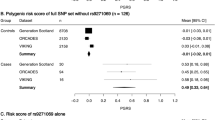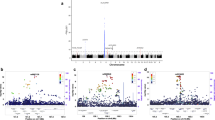Abstract
Multiple sclerosis (MS) is the most common chronic inflammatory neurologic disorder diagnosed in young adults and, due to its chronic course, is responsible for a substantial economic burden. MS is considered to be a multifactorial disease in which both genetic and environmental factors intervene. The well-established human leukocyte antigen (HLA) association does not completely explain the genetic impact on disease susceptibility. However, identification and validation of non-HLA-genes conferring susceptibility to MS has proven to be difficult probably because of the small individual contribution of each of these genes. Recently, associations with two single nucleotide polymorphisms (SNPs) in the IL2RA gene (rs12722489, rs2104286) and one SNP in the IL7RA gene (rs6897932) have been reported by several groups. These three SNPs were genotyped in a French and a German population of MS patients using the hME assay by the matrix-assisted laser desorption/ionization time of flight technology (Sequenom, San Diego, CA, USA). We show that these SNPs do contribute to the risk of MS in these two unrelated European MS patient populations with odds ratios varying from 1.1 to 1.5. The discovery and validation of new genetic risk factors in independent populations may help toward the understanding of MS pathogenesis by providing valuable information on biological pathways to be investigated.
This is a preview of subscription content, access via your institution
Access options
Subscribe to this journal
Receive 6 digital issues and online access to articles
$119.00 per year
only $19.83 per issue
Buy this article
- Purchase on Springer Link
- Instant access to full article PDF
Prices may be subject to local taxes which are calculated during checkout
Similar content being viewed by others
References
Rosati G . The prevalence of multiple sclerosis in the world: an update. Neurol Sci 2001; 22: 117–139.
Sotgiu S, Pugliatti M, Sotgiu A, Sanna A, Rosati G . Does the ‘hygiene hypothesis’ provide an explanation for the high prevalence of multiple sclerosis in Sardinia? Autoimmunity 2003; 36: 257–260.
Dyment DA, Willer CJ, Scott B, Armstrong H, Ligers A, Hillert J et al. Genetic susceptibility to MS: a second stage analysis in Canadian MS families. Neurogenetics 2001; 3: 145–151.
Sadovnick AD, Ebers GC, Dyment DA, Risch NJ . Evidence for genetic basis of multiple sclerosis. The Canadian Collaborative Study Group. Lancet 1996; 347: 1728–1730.
Lindsey JW . Familial recurrence rates and genetic models of multiple sclerosis. Am J Med Genet A 2005; 135: 53–58.
Oksenberg JR, Barcellos LF . Multiple sclerosis genetics: leaving no stone unturned. Genes Immun 2005; 6: 375–387.
Haines JL, Terwedow HA, Burgess K, Pericak-Vance MA, Rimmler JB, Martin ER et al. Linkage of the MHC to familial multiple sclerosis suggests genetic heterogeneity. The Multiple Sclerosis Genetics Group. Hum Mol Genet 1998; 7: 1229–1234.
Hillert J . Multiple sclerosis: postlinkage genetics. Clin Neurol Neurosurg 2006; 108: 220–222.
Lundmark F, Duvefelt K, Iacobaeus E, Kockum I, Wallstrom E, Khademi M et al. Variation in interleukin 7 receptor alpha chain (IL7R) influences risk of multiple sclerosis. Nat Genet 2007; 39: 1108–1113.
Gregory SG, Schmidt S, Seth P, Oksenberg JR, Hart J, Prokop A et al. Interleukin 7 receptor alpha chain (IL7R) shows allelic and functional association with multiple sclerosis. Nat Genet 2007; 39: 1083–1091.
The International Multiple Sclerosis Genetics Consortium. Risk alleles for multiple sclerosis identified by a genomewide study. N Engl J Med 2007; 357: 851–862.
Zhang Z, Duvefelt K, Svensson F, Masterman T, Jonasdottir G, Salter H et al. Two genes encoding immune-regulatory molecules (LAG3 and IL7R) confer susceptibility to multiple sclerosis. Genes Immun 2005; 6: 145–152.
Ebers GC, Kukay K, Bulman DE, Sadovnick AD, Rice G, Anderson C et al. A full genome search in multiple sclerosis. Nat Genet 1996; 13: 472–476.
Oturai A, Larsen F, Ryder LP, Madsen HO, Hillert J, Fredrikson S et al. Linkage and association analysis of susceptibility regions on chromosomes 5 and 6 in 106 Scandinavian sibling pair families with multiple sclerosis. Ann Neurol 1999; 46: 612–616.
Akesson E, Coraddu F, Marrosu MG, Massacesi L, Hensiek A, Harbo HF et al. Refining the linkage analysis on chromosome 10 in 449 sib-pairs with multiple sclerosis. J Neuroimmunol 2003; 143: 31–38.
Matesanz F, Caro-Maldonado A, Fedetz M, Fernandez O, Milne RL, Guerrero M et al. IL2RA/CD25 polymorphisms contribute to multiple sclerosis susceptibility. J Neurol 2007; 254: 682–684.
Sawcer S . A new era in the genetic analysis of multiple sclerosis. Curr Opin Neurol 2006; 19: 237–241.
Ramagopalan SV, Anderson C, Sadovnick AD, Ebers GC . Genomewide study of multiple sclerosis. N Engl J Med 2007; 357: 2199–2200.
Matesanz F, Fernandez O, Alcina A . Genomewide study of multiple sclerosis. N Engl J Med 2007; 357: 2200–2201.
Bourgain C, Genin E, Cox N, Clerget-Darpoux F . Are genome-wide association studies all that we need to dissect the genetic component of complex human diseases? Eur J Hum Genet 2007; 15: 260–263.
Clerget-Darpoux F, Elston RC . Are linkage analysis and the collection of family data dead? Prospects for family studies in the age of genome-wide association. Hum Hered 2007; 64: 91–96.
Hafler DA, Slavik JM, Anderson DE, O’Connor KC, De Jager P, Baecher-Allan C . Multiple sclerosis. Immunol Rev 2005; 204: 208–231.
Seddon B, Tomlinson P, Zamoyska R . Interleukin 7 and T cell receptor signals regulate homeostasis of CD4 memory cells. Nat Immunol 2003; 4: 680–686.
He YW, Malek TR . Interleukin-7 receptor alpha is essential for the development of gamma delta + T cells, but not natural killer cells. J Exp Med 1996; 184: 289–293.
McKay FC, Swain LI, Schibeci SD, Rubio JP, Kilpatrick TJ, Heard RN et al. Haplotypes of the interleukin 7 receptor alpha gene are correlated with altered expression in whole blood cells in multiple sclerosis. Genes Immun 2008; 9: 1–6.
Peltonen L . Old suspects found guilty—the first genome profile of multiple sclerosis. N Engl J Med 2007; 357: 927–929.
Marrosu MG . Susceptibility to multiple sclerosis: the role of interleukin genes. Lancet Neurol 2007; 6: 846–847.
Poser CM, Paty DW, Scheinberg L, McDonald WI, Davis FA, Ebers GC et al. New diagnostic criteria for multiple sclerosis: guidelines for research protocols. Ann Neurol 1983; 13: 227–231.
McDonald WI, Compston A, Edan G, Goodkin D, Hartung HP, Lublin FD et al. Recommended diagnostic criteria for multiple sclerosis: guidelines from the international panel on the diagnosis of multiple sclerosis. Ann Neurol 2001; 50: 121–127.
Robins LN, Wing J, Wittchen HU, Helzer JE, Babor TF, Burke J et al. The Composite International Diagnostic Interview. An epidemiologic Instrument suitable for use in conjunction with different diagnostic systems and in different cultures. Arch Gen Psychiatry 1988; 45: 1069–1077.
Binder EB, Salyakina D, Lichtner P, Wochnik GM, Ising M, Putz B et al. Polymorphisms in FKBP5 are associated with increased recurrence of depressive episodes and rapid response to antidepressant treatment. Nat Genet 2004; 36: 1319–1325.
Dudbridge F . Pedigree disequilibrium tests for multilocus haplotypes. Genet Epidemiol 2003; 25: 115–121.
Acknowledgements
We thank the members of REFGENSEP, a national network for the study of MS genetics in France for their active contribution and for referring patients. REFGENSEP is supported by grants from INSERM, AFM, ARSEP, Groupe Malakoff and Biogen-Idec, and received help from Genethon and CIC Pitié-Salpêtrière. The DNA bank from Würzburg was supported by a grant from the Gemeinnützige Hertie Stiftung (GHS). We gratefully acknowledge expert technical assistance of S Damast, S Sauer and M Koedel.
Author information
Authors and Affiliations
Corresponding author
Rights and permissions
About this article
Cite this article
Weber, F., Fontaine, B., Cournu-Rebeix, I. et al. IL2RA and IL7RA genes confer susceptibility for multiple sclerosis in two independent European populations. Genes Immun 9, 259–263 (2008). https://doi.org/10.1038/gene.2008.14
Received:
Revised:
Accepted:
Published:
Issue Date:
DOI: https://doi.org/10.1038/gene.2008.14
Keywords
This article is cited by
-
IL7RA genetic variants differentially affect IL-7Rα expression and alternative splicing: a role in autoimmune and infectious diseases?
Genes & Immunity (2020)
-
Do Human Endogenous Retroviruses Contribute to Multiple Sclerosis, and if So, How?
Molecular Neurobiology (2019)
-
Association of interleukin 6, interleukin 7 receptor alpha, and interleukin 12B gene polymorphisms with multiple sclerosis
Acta Neurologica Belgica (2018)
-
Interleukin-2 receptor-α proximal promoter hypomethylation is associated with multiple sclerosis
Genes & Immunity (2017)
-
Persistent coxsackievirus B4 infection induces microRNA dysregulation in human pancreatic cells
Cellular and Molecular Life Sciences (2017)



